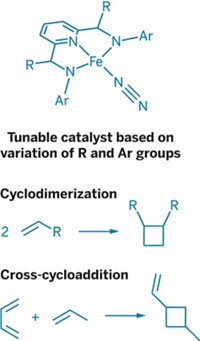Advertisement
Grab your lab coat. Let's get started
Welcome!
Welcome!
Create an account below to get 6 C&EN articles per month, receive newsletters and more - all free.
It seems this is your first time logging in online. Please enter the following information to continue.
As an ACS member you automatically get access to this site. All we need is few more details to create your reading experience.
Not you? Sign in with a different account.
Not you? Sign in with a different account.
ERROR 1
ERROR 1
ERROR 2
ERROR 2
ERROR 2
ERROR 2
ERROR 2
Password and Confirm password must match.
If you have an ACS member number, please enter it here so we can link this account to your membership. (optional)
ERROR 2
ACS values your privacy. By submitting your information, you are gaining access to C&EN and subscribing to our weekly newsletter. We use the information you provide to make your reading experience better, and we will never sell your data to third party members.
Synthesis
Olefin Metathesis For Macrocycles
Organic Synthesis: Tungsten catalysts make macrocyclic olefins with Z-selectivity
by Bethany Halford
November 3, 2011

When it comes to assembling macrocyclic olefins, few reactions can compete with the ease and efficiency of ring-closing metathesis. But the reaction has a downside: It suffers from poor stereoselectivity, usually producing a mixture of E and Z olefins. Now, thanks to new tungsten alkylidene catalysts, chemists can make Z olefins with up to 97% selectivity via ring-closing metathesis (Nature, DOI: 10.1038/nature10563).
Researchers led by Boston College chemistry professor Amir H. Hoveyda and MIT chemistry professor Richard R. Schrock developed the selective catalysts and used them to boost the overall yields of the complex natural products epothilone C and nakadomarin A. Earlier syntheses of these compounds were marred by late-stage ring-closing metathesis reactions that produced a mixture of E and Z isomers that were difficult to separate.
The fact that the chemists who made those molecules previously even used ring-closing metathesis, knowing it would give them a mixture of isomers, speaks to the power of the reaction, says Hoveyda. “As synthetic chemists, we don’t use reactions that are not selective, but ring-closing olefin metathesis makes your synthesis so much more efficient that many synthetic chemists still opt to use it rather than the alternative methods of making rings,” he points out. “That is why having a selective version of this is so important.”
Z-Selective ring-closing metathesis poses different challenges than that of Z-selective cross-metathesis—a problem Hoveyda and Schrock tackled earlier this year (C&EN, March 28, page 9). It’s not possible to use excess amounts of one coupling partner to influence the formation of the desired product, for example. And once a ring is closed, it will often rereact with the catalyst to open up and relieve strain.
“You want this catalyst to walk a tightrope—being just reactive enough to ring-close the terminal olefins but never come back and react with the cis double bond that it forms,” Hoveyda explains. “Tungsten gives you that window,” he says, and the arrangement of the ligands around the tungsten dictates the stereochemical outcome of the metathesis reaction. What’s more, thanks to its reactive profile, the catalyst can be handled in air even in the humidity of a Boston summer, Hoveyda adds. That’s not the case with molybdenum metathesis catalysts.
K. C. Nicolaou, an expert in natural product synthesis at Scripps Research Institute, says that new catalysts’ ability to do Z-selective ring-closing metathesis “is important because many biologically active natural products with such structural motifs can now be accessed through chemical synthesis stereoselectively.” He adds, “This milestone achievement will be welcomed by the synthetic community as a major advance in organic synthesis.”





Join the conversation
Contact the reporter
Submit a Letter to the Editor for publication
Engage with us on Twitter